
As a drummer, the first time you hear of the cajon, you’re instantly fascinated.
A kick, a snare, toms, and even a chair…all wrapped in one???
For impromptu live jam sessions, what could be simpler than that?
But the truth is, once you start really exploring this instrument, you’ll find that there’s a lot more to it than you originally thought.
So in today’s ultimate guide, I’m answering all the typical questions drummers have, when shopping for their first cajon.
First up…
Anatomy of the Cajon: The 4 Parts to Know
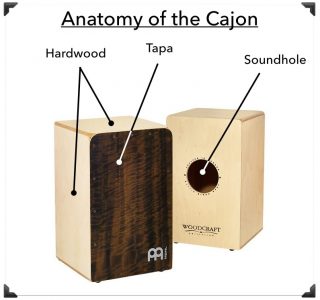
To truly understand this instrument, we’ll start by looking at its individual components.
The 4 most important parts that determine a cajon’s sound are:
- Tapa – the thin playing surface on the front
- Hardwood Body – which makes up the remaining box surfaces
- Soundhole – where sound exits the box
- Snare – located inside the cajon, against the tapa
Now let’s take a closer look at each one…
1. What Makes a Great Sounding Cajon Tapa?
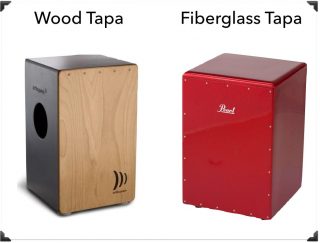
The Tapa, (aka the front plate), is the main playing surface of the cajon.
The features that determine its sound are:
- Construction Material – carbonfiber and fiberglass models are louder and more durable, while wood is lighter and cheaper.
- Layer Count and Thickness – thinner layers and higher layer counts offer a crisper and overall better sound.
- Looseness – The looser it sits against the body the better the “slapping” sound.
Up next…
2. What Makes a Good Cajon Body?
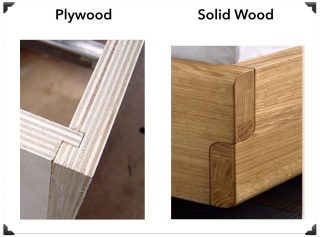
Cajon bodies are typically made of either layered plywoods, or a single solid pieces.
As a general rule of thumb, hardwoods work better than soft, the 4 most common woods being:
- Mahogany
- Oak
- Beech
- Birch
Unlike most instruments, whose sound is strongly influenced by choice of wood, with cajons, it’s actually very difficult to hear any real differences…
With the exception of oak, which is louder sound due to its unique hardness..
Up next…
3. How the Soundhole Position Influences Sound
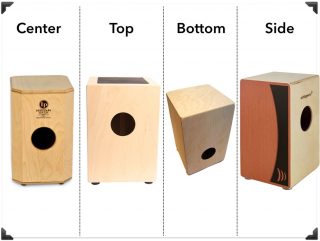
The position of the soundhole also influences the sound of the cajon.
It is most often placed on the rear plate as it is the quickest way out for the sound, but sometimes you’ll find it on one of the sides.
Now here is how the position of the soundhole affects the tone:
- Rear Off-center: More sustain and depth, less volume.
- Rear Centered: Higher volume, less sustain.
- Side: A good choice for small live settings in the case the cajon is not mic’d.
Up next…
4. Guitar String Snares vs Drum Snares
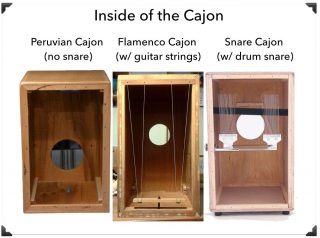
With cajon snares, you have 3 options:
- No Snares – which is how they were originally played in Peru (where they were invented).
- Guitar String Snares – aka the Flamenco Cajon
- Drum Snares – which are the same as those used on a typical snare drum.
Because Pervian cajons have no snare sound, they aren’t typically used as a portable drum kit replacement – and are more commonly played in a traditional Peruvian ensembles.
So for most people reading this post, you DON’T want these.
If this is the type of sound you’re looking for, here’s a model I recommend:
- A Tempo Percussion Peruvian Classic – (Amazon)
For the other 99% of you reading this article…the slap sound of the snare is a must-have to replace the drum kit. In which case your options are either Flamenco or snare cajons.
So let’s take a closer look at each of these now. Starting first with…
Flamenco Cajons
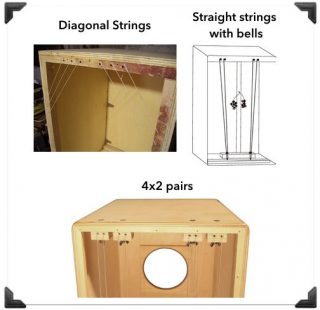
Flamenco cajons gained popularity thanks to Paco de Lucia, probably the most famous flamenco guitar player ever.
While on tour in Peru in the 1970s, he was gifted a cajon and thought it would fit flamenco music.
Guitar strings were added to add more texture to the sound and that’s how the flamenco cajon was born.
Here are the main characteristics of flamenco cajons:
- Guitars strings are stretched across the back of the tapa, producing a sizzle
- Sound is tight and precise
- Allows for a more technical (fast/controlled) playing than any other type of cajon.
On the image beside you can see a few examples of the string setting but the truth is there are many more ways of displaying these strings. The most relevant shape is the diagonal setting though, and that is because…
After players started complaining that no matter where you strike the tapa, the snare would vibrate.
And so to address this issue, some brands started stretching the strings diagonally accross the corner making them vibrate only when the top corners are played, and leaving the bass completely “buzzless”, keeping a clean, deep sound.
Here are the models I recommend:
Budget Models:
- Sawtooth String Cajon – (Amazon)
- Pyle String Cajon – (Amazon)
- Amazon Basic String Cajon – (Amazon)
- LP Black Box – (Amazon/Thomann)
Mid Range Models:
- Meinl Headliner Series – (Amazon/Thomann)
- Gon Bops Fiesta w/bells – (Amazon)
- Meinl Woodcraft Professional Series – (Amazon/Thomann)
- Meinl Makah Burl – (Amazon)
High-End Models
Also check out this model by Meinl which features a fiberglass tapa:
- Meinl Fiberglass Frontplate – (Amazon)
For a fully synthetic cajon, check out this model which is made ouf of acrylic for the body and fiberglass for the tapa:
- Tycoon 29 Series – (Amazon)
Snare Cajons
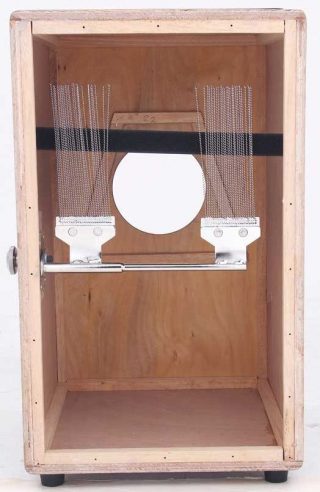
Snare cajons typically produce a wider sound, and therefore don’t allow for an overly technical playing, unlike flamenco cajons.
This design offers:
- The same snare as the one found on a snare drum
- More flexibility: you can switch the snare off
- The more wires, the more sizzle
- Sound is not as “tight” as a flamenco cajon
- Great for emulating a drum kit
Each manufacturer has its own number of snare, but you’ll most commonly see two sets of snares, each one made of many little wires, just like on the picture on the right.
Check out this video to hear what it sounds like:
So if you want to find that drumsnare slap sound on your cajon, that’s the type you’re looking for.
Here’s what I recommend:
- Schlagwerk 2inOne – (Amazon/Thomann)
- Meinl Snare – (Amazon)
- Meinl Jumbo Bass – (Amazon/Thomann)
- LP Aspire Accents w/3 sets of snares – (Amazon/Thomann)
Adjustable Snare Cajons
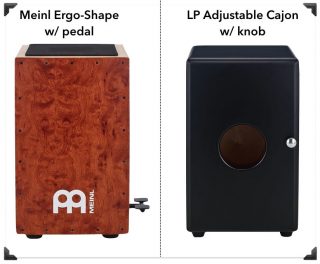
Thanks to a knob or pedal, adjustable cajons allow you to change the snare response by simply loosening or tightening the snare wires/strings/brushes.
You can also turn it off completely.
Check out this video to see this cajon in action:
Here are the models I recommend:
Adjustable Snare Cajons :
- LP Adjustable Snare – (Amazon/Thomann)
- Meinl Ergo-Shape Pedal Snare – (Amazon)
- Sawtooth Adjustable Snare – (Amazon)
Adjustable Flamenco Cajons :
Four Unique Cajon Models to Check Out
Nowadays you can find all sorts of new innovations to this instrument, but there are 4 in particular that I recommend you check out:
1. Acrylic Cajons
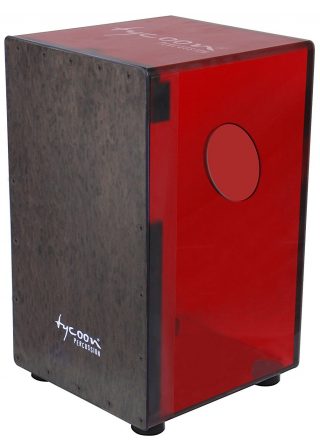
Acrylic cajons are considered the most durable option. Their sound is not as warm as a wooden model, but that’s not necessarily a downside, especially if you gig a lot.
So far the only brand to produce this design is Tycoon and as you can see on the picture, the tapa is actually still made of wood.
They have a very crisp and bright sound, which can suit some situation, such as live settings.
Now, these are some very expensive options, but if you appreciate their sound and can afford them, definitely go for it as reviews seem to indicate an amazing sound.
You can hear what they sound like in the video below:
If you dig this sound, check out the models I recommend:
2. Schlagwerk Agile Dual
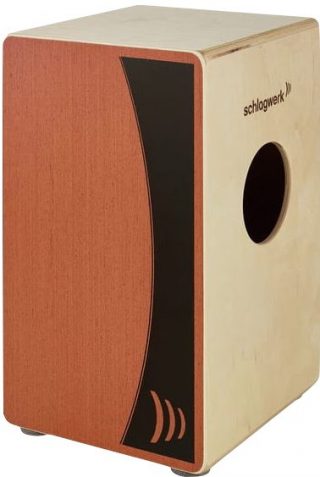
Can’t make up your mind between a Peruvian and snare cajon?
Then try this option…
Its sound hole is placed on the side — as opposed to the back for most models — which allows you to play on both front and rear plate.
One of the plates has a snare so you can choose between a snare cajon and a more traditional Peruvian cajon.
You can also take the snare out and put it on the other plate, which will change the pitch.
With this model you basically get 2 instruments in one.
Check out this video by Schlagwerk to hear both sounds:
- Click to compare prices – (Amazon)
If you like this concept, check out this similar cajon from the Peruvian brand A Tempo :
- A Tempo Dos Voces – (Amazon)
3. Roland EL (electro-acoustic cajon)
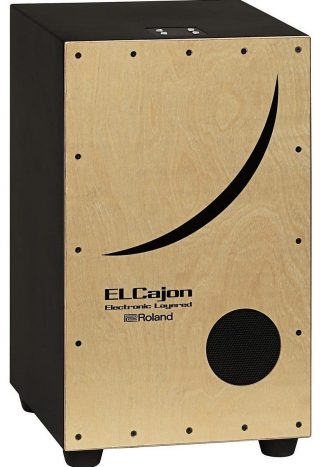
This Cajon is the first electro-acoustic model invented.
It’s a flamenco cajon with built-in amplification and battery, as well as a Roland sound module.
It works on regular batteries but can also be plugged into an electrical outlet.
Useful features include:
- Ability to switch between elctronic and acoustic sound while playing.
- Adjustable sensors sensitivity
- 3.5 jack input
- Ability to turn on and off a specific trigger (bass or snare)
If you’re a drummer you probably already know Roland for their electronic drumkits, which are considered to be among the best in the world.
Check out this comprehensive video explaining all of its features :
Click to compare prices – (Amazon/B&H/Thomann)
4. Meinl Slap-Top Cajon
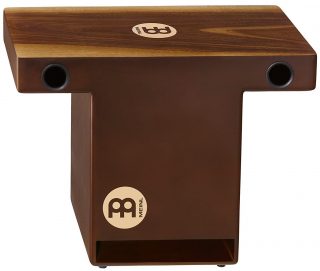
Here is a cajon that you do not sit on.
This model was made to be played on the top plate, while being secured between your legs.
Here are its main features :
- 1 bass port and 2 top ports, all placed in the FRONT
- 2 snares on each end of the top part
The main advantage of this design is that the sound is projected forward, as opposed to backwards on a regular design.
Rave reviews and a relatively low price are two added assets of this cajon.
Check out this video to see what it’s capable of :
Click to compare prices – (Amazon/Thomann)
If you like this one, check out this similar model:
Finally, check out the Meinl BassBox which is basically a kick drum cajon:
Cajon Accessories
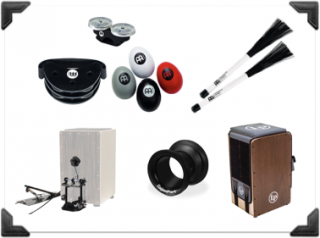
Surprisingly, you’ll find that there are actually A LOT of accessories on the market…
And that might be due to the fact that the cajon is such a “simple” instrument.
Now, “purists” will tell you a cajon should never be played with any added accessory…
But the tuth is some of them will definitely extend your range of sonic possibilities. Just like when you add a new element to your drum kit.
So here is my list of the 5 best cajon accessories:
- Meinl Cajon Accessory Pack
- Retractable Cajon Brush
- ChromaCast CC-CPDL Cajon Pedal
- Kickport CajonPort
- LP Cajon Saddle
First up…
1. Meinl Cajon Accessory Pack

This bundle by Meinl includes three small percussions:
- Meinl Foot Tambourine
- 4 egg shakers with different sounds
- Aluminium Fingers jingle
Click to see current price – (Amazon)
2. Retractable Cajon Brush

If you’re a drummer and already play with brushes, you’ll probably be surprised to learn that there are actually brushes specifically made for cajons.
At least that’s what the brand Meinl claims.
But since nylon brushes already exist for regular drums, it’s very likely you could just as well use brushes that are not labeled “cajon brushes”, especially if you already own a pair.
To get a better idea on how to use these and what they sound like, check out this video :
3. Cajon Pedals

These pedals allow you to turn your cajon into a bass drum, whether you use it in a kit or while playing guitar, for example.
Designed by drummers, this pedal provides the same feeling as with a regular kick drum pedal.
- ChromaCast Cajon Pedal – (Amazon)
A recurring problems that seems to affect these pedals is the cable breaking. Meinl appear to have understood this issue and came up a “wireless” pedal. Check it out :
4. LP Cajon Saddle

Sitting for hours on a cajon can become challenging once you start doing it on a regular basis.
With this accessory, not only do you get to sit more comfortably, but you also get a quick access to your other percussion accessories thanks to a brush holder and a pouch placed on each side.
- Click to compare current price – (Amazon)
5. Meinl Cajon Drum Set
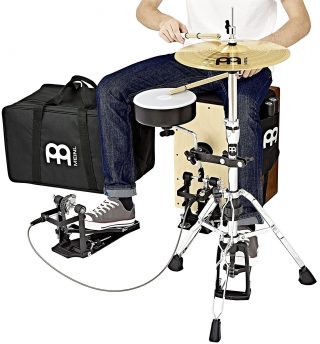
Here is the ultimate solution if you need a truly “portable” drumkit.
This Meinl set includes :
- A snareless Meinl Cajon, for the kickdrum
- A Meinl kick pedal
- A Snare
- Hihat
Probably the best alternative to a “real” drumkit if you need to play in smaller venues, or any other place where a regular drumkit is too loud.
Check out this video to see the Meinl Cajon Drumset in action :
By the way, if you found this post useful, I highly recommend joining our free Home Recording Secrets email newsletter where you’ll discover….
- How to Get Your First Studio Up and Running in a Single Weekend
- How to Avoid Wasting Thousands of Dollars on Unnecessary Pointless Purchases
- How to Get a “Million Dollar” Pro Studio Sound in a “Thousand Dollar” Home Studio
- PLUS… All Sorts of Other Amazing Insider Secrets Revealed
And it’s totally FREE! Click here and Enter Your Email to Sign Up.
More Drum/Percussion Posts in this Series:
Drum Sets | Electronic Drums | Snares | Drumheads | Cymbals | Djembe | Bongos | Cajon | Conga | Cowbell | Tambourines | Vibraphones | Xylophones | Marimbas | Glockenspiels | Metronomes | Drum Thrones | Drumsticks | Ride Cymbals